Parasitology, Vaccination, Nutrition
1/25
There's no tags or description
Looks like no tags are added yet.
Name | Mastery | Learn | Test | Matching | Spaced |
|---|
No study sessions yet.
26 Terms
define:
symbiosis
…
define the types of symbiosis:
parasitism
commensalism
mutualism
amensalism
interaction among organisms where 1 lives w/ in or on the body of another
…
1 organism benefits, the other is harmed (e.g. heartworms in dog)
1 organism (the commensal) benefits, the other (the host) isn’t harmed nor helped (e.g. barnacles on whale)
both host & symbiont benefit (e.g. bees & flowers)
1 dies, the other is unaffected (e.g. goats eating flowers)
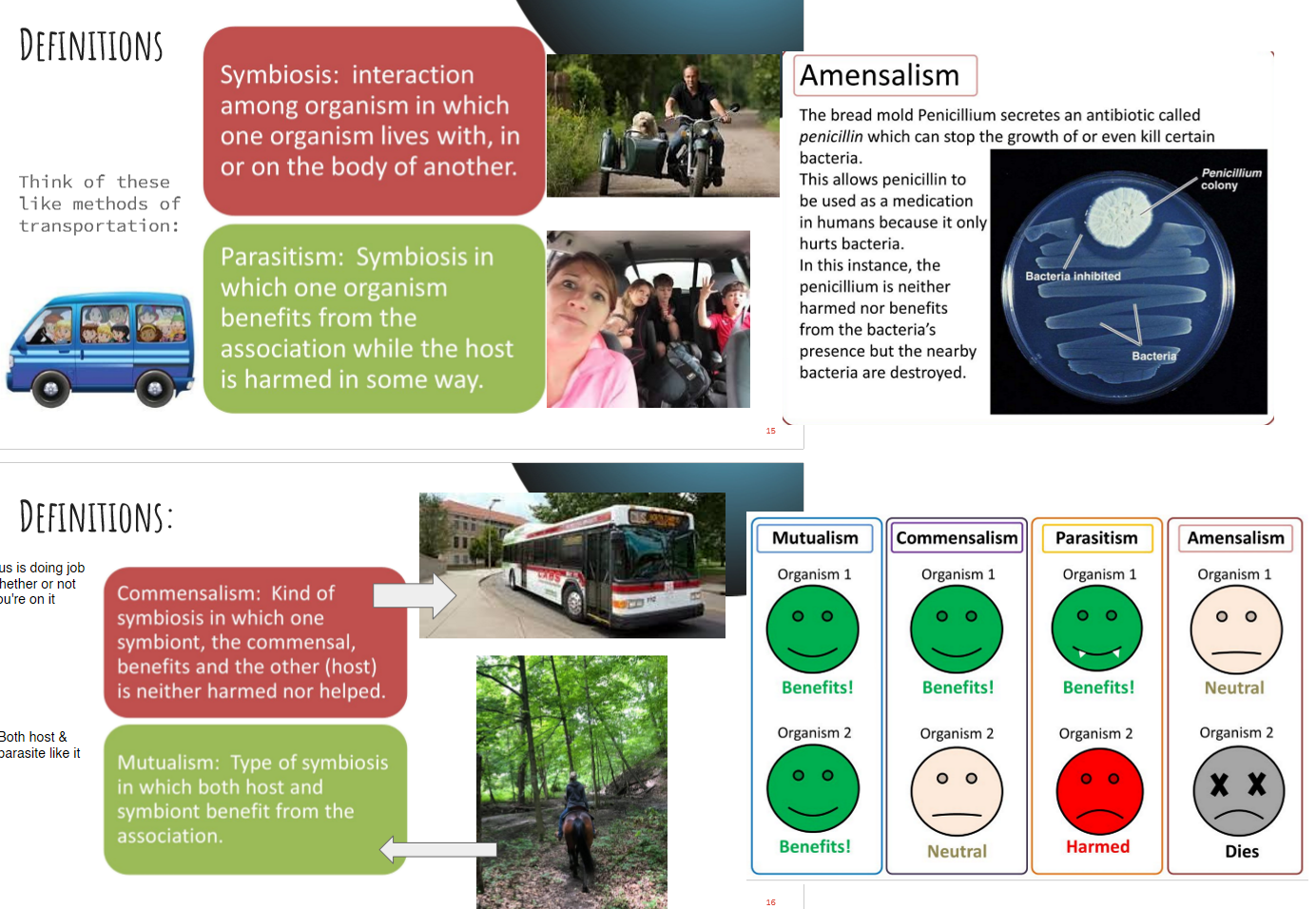
whats the parasite & host in parasitism
parasite: the organism that benefits from the host
host: the organism thats harmed
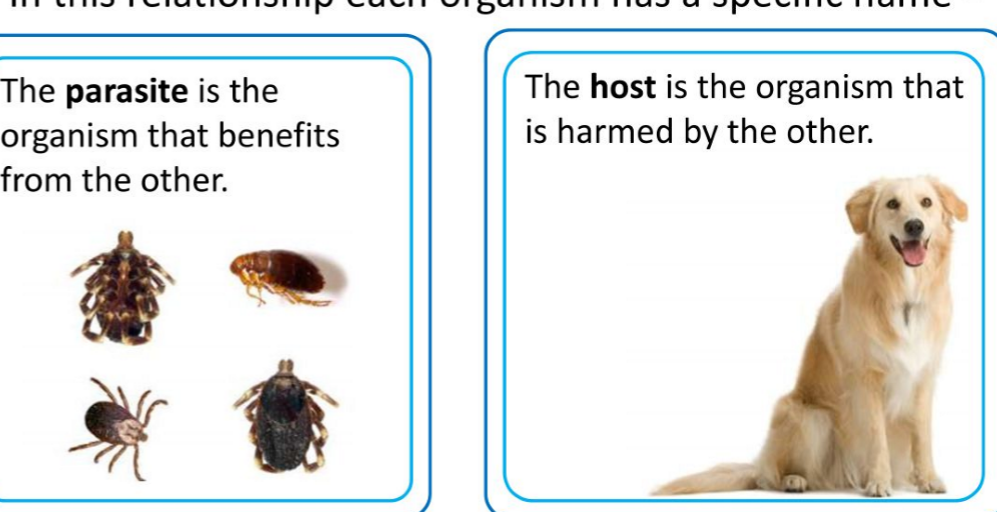
give pros & cons of parsitism for both the parasite & the host
parasite:
pro: easy life for them, they just hop on
con: makes them dependent on another for survival, they can’t live on their own
host:
pro: survival of the fitest leads to genetic diversity
con: nutrients being taken, blood being taken (exsanguination), mechanicanl obstruction, wasting energy on immune reponses to psite, can get infectious disease from psite, can force them into abortion, secondary infections, force host to have detrimental behvaior (e.g. dog itching from fleas)
understanding how psites get into a host can help us pick tx.
…
name some of the ways psites get into a host
which is the most common
penetrate the skin (e.g. roundworms), vector (inoculation), direct contact w/ mucosal surfaces or ectopsites, in utero transmission to baby or during birth or transmammary
most common: ingestion (fecal oral)
parasites can have a direct or indirect life cycle.
…
define each
describe the most common way each are transmitted
give an example of each
direct: a single host is enough for them to complete their entire life cycle
transmit directly host to host, usually via direct contact or ingestion of eggs or larvae (e.g. lice, mange)
indirect: require at LEAST 2 hosts → definitive & intermediate host
usually move from defin to intermed host via vector (e.g. flea, tick, mosquito)
…
note: one life cycle = time from development to sexual repro
some psites have an indirect life cycle which requires a definitive & intermediate host.
define each
defin: host where psite reaches sexual maturity & reproduces
inter: host where psite does develops but doesn’t reach sexual maturity
many psites spend time off the host during their life cycle so we most treat both the host & the environment it lives in to actually make a difference.
…
explain this by describing the life cycle of fleas & ticks
flea: adult lives on host, eggs/larvae/pupae usually found in environment (they loveee carpet, bedding, soil, etc.)
…
tick: leave host and live in vegeatation or leaf litter between life stages (larvae, nymph, adult) to molt & find new host
define ectoparasite
an organism that lives on the surface of an animals body, skin, or ears & feeds off the host (e.g. mites, fleas, ticks, lice, flying insects)
mites…
direct or indirect life cycle?
how are they transmitted
S&S
direct → stays on host entire time (egg, larva, nymph, adult)
direct contact & fomites
itching, scratching, hair loss, redness, crust, scabs
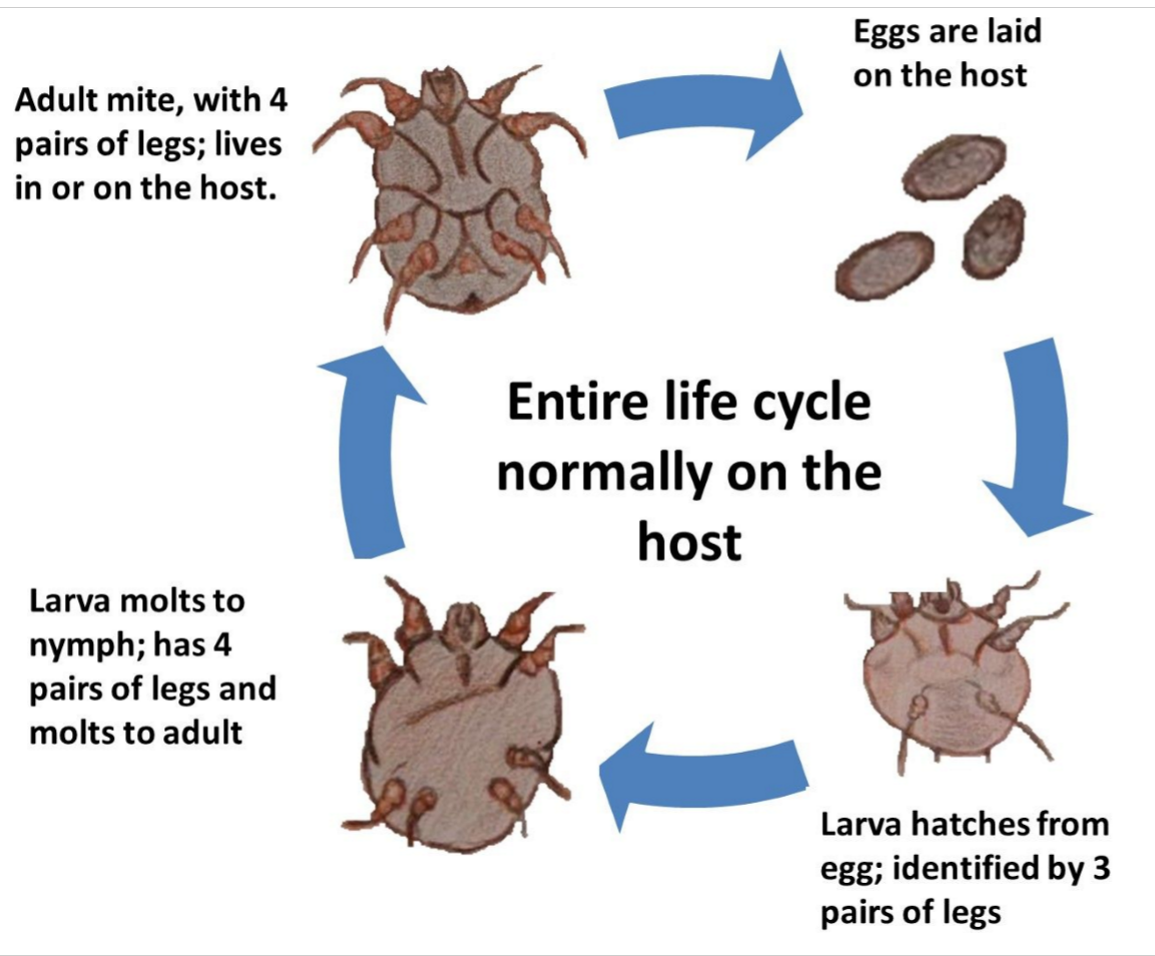
fleas…
direct or indirect life cycle?
are they host specific
explain why its critical to do tx for monthssss (not just 1 month)
how are S&S diff than lice
can they carry diseases & pass on to your pet?
indirect → adults on animals, eggs fall off into environment
no (e.g. can go from cat to dog)
egg can hang out for monthsss until conditions are optimal for survival
fleas show irritation/itching in specific parts of body, lice show all over body
yes (e.g. tapeworms)
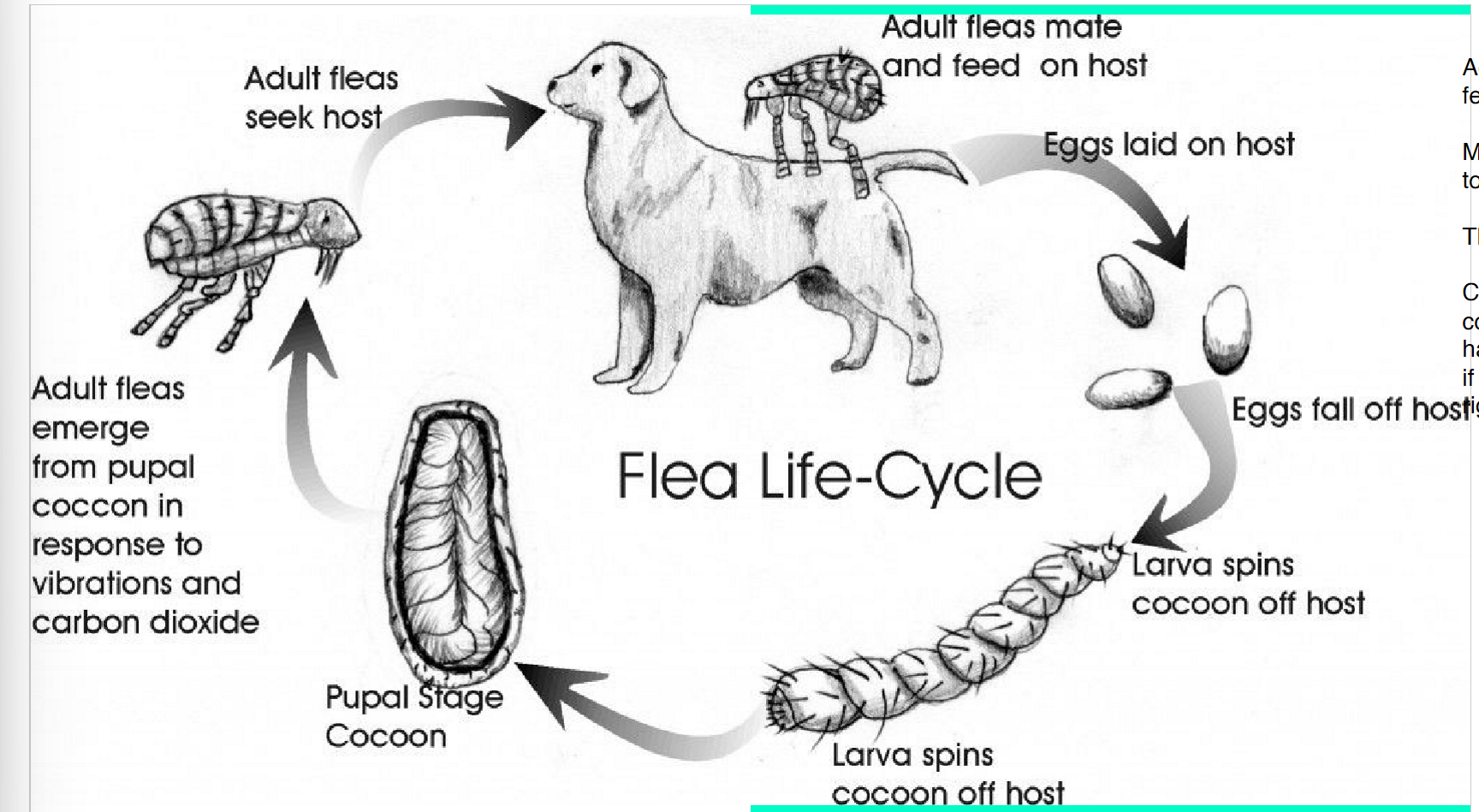
ticks…
direct or indirect life cycle?
S&S
can they carry diseases & pass on to your pet?
…
describe how we try to prevent tick-borne diseases on an international level
what about on an individual farm
can be either (superrrr dynamic)
physically see the tick or show S&S monthsss later
yes and they do a lot!!! (2nd to mosquitos in terms of importance in public health)
…
lots of restrictions preventing moving ani w/ tick diseases
keep grass low, repellant in field & on animals, meds, etc.

lice…
direct or indirect life cycle?
are they host specific
under what husbandry conditions are lice more common
how are S&S diff than fleas
can be either (they prefer direct though)
yes (unlike fleas)
stressed animals or group housing (common in LA’s)
show S&S all over body, fleas will be irritation in specific parts of body
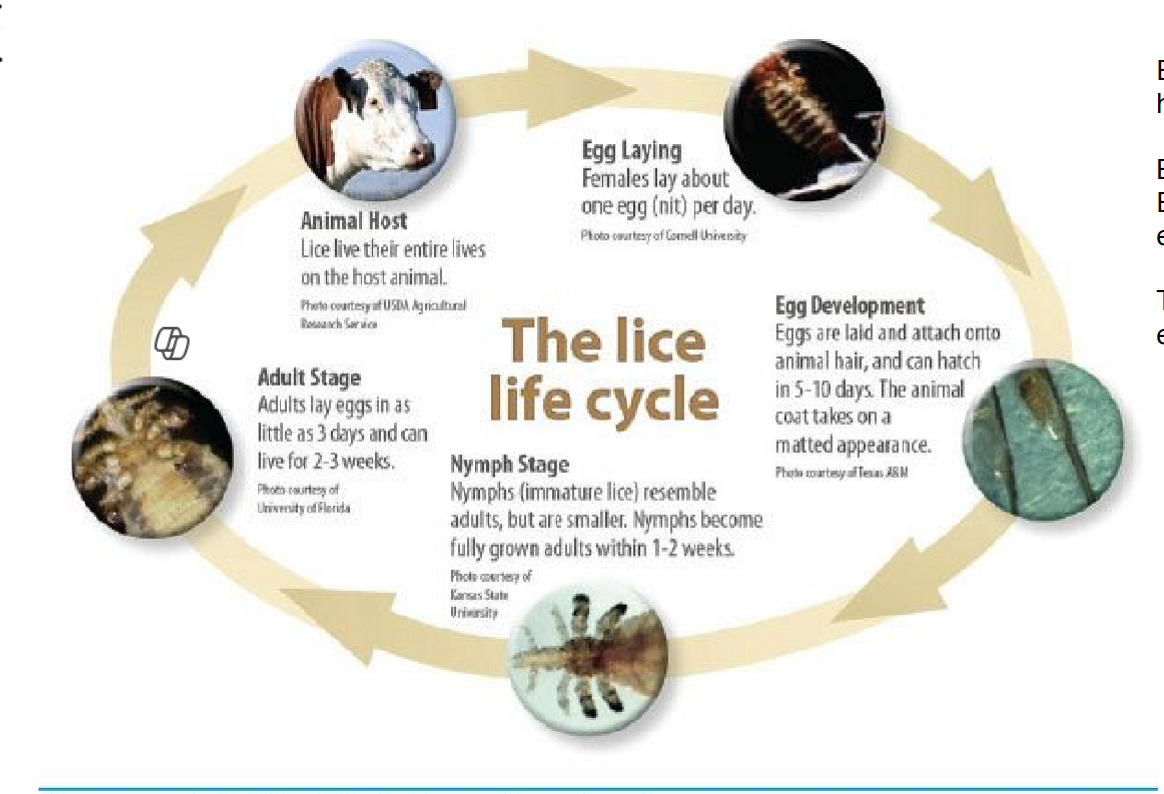
flying insects (flies, mosquitos, culicoides)…
direct or indirect life cycle?
…
these are best controled/treated by making environmental changes.
give some examples of things we can do
indirect
eliminate breeding sites (e.g. manure, clean waterers), physical traps/barriers (e.g. screens, fans), use insecticide sprays, rotate chemicals to prevent resistance, fly masks

define these type of hosts parasites can have:
paratenic/tansport host
aberrant hose
psite stays alive but doesn’t develop while on this host (its like it goes into hiding)
psite ends up on the wrong host, dead end
endoparasites…
nematodes, cestodes, & trematodes can all be categorized as helminths.
…
whats the diff between helminths & protozoa (also a type of endopsite)?
helminth: a multicellular worm (e.g. roundworms, tapeworms, flukes)
prot: single celled psites that live in various tissues (usually GIT or blood)
protozoas (e.g. giardia, coccidia, cryptosporidium)…
direct or indirect life cycle?
describe how they’re transmitted
using this ^, describe some of the best ways we can prevent/control them
either
oocysts or cysts transmitted via vectors (tick/mosquito) ingesting them or get in food/water that animals eat/drink
hygiene!! clean kennels!!, rotate pastures, remove waste often, vector control via inscticides or topicals, dewormers
nematodes…
whats the common name of these
where do they commonly live in the host
direct or indirect life cycle?
describe how they’re transmitted
using this ^, describe some of the best ways we can prevent/control them
roundworms (non-segmented, symmetrical worms, move in S shape motion)
GIT (pinworms) or heart (heartworms)
either
eggs pass in feces, hatch in environment → ani eats them on pasture
regular deworming (be careful, nematodes are known to become resistant to LA dewormers!!), remove feces daily, pasture mngmt, prevent pets from eating poop
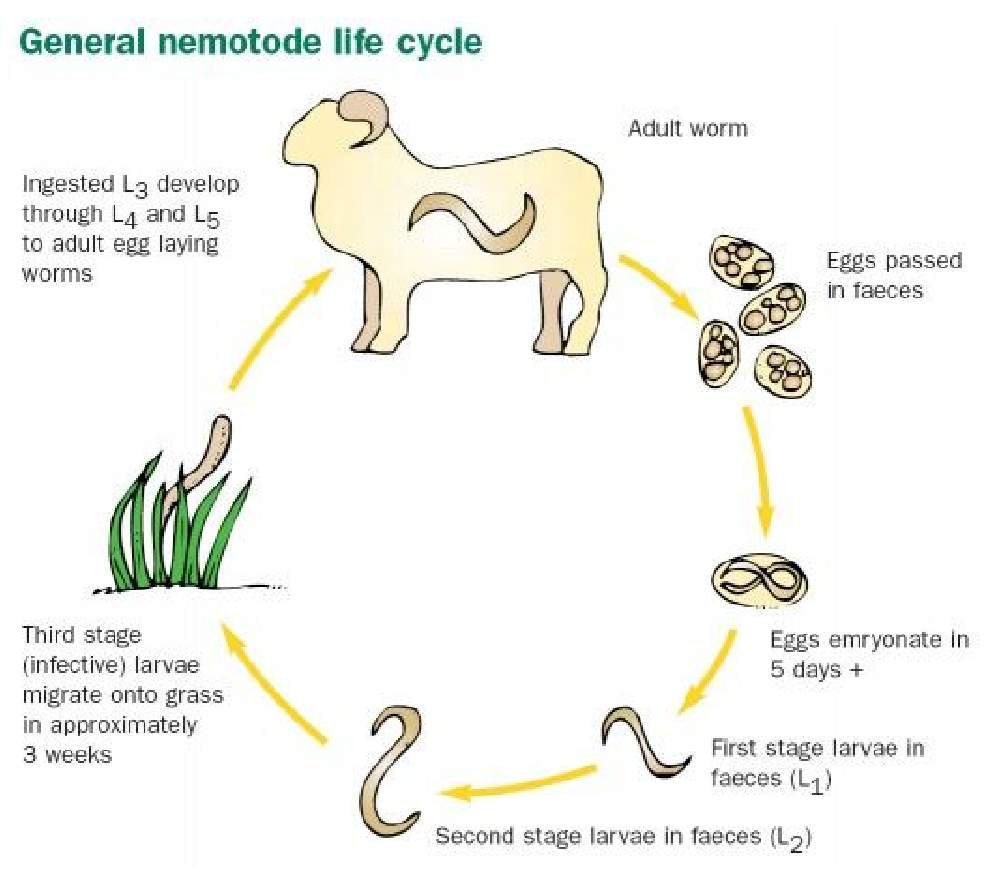
cestodes…
whats the common name of these
where do they commonly live in the host
direct or indirect life cycle?
cestodes usually aren’t pathogenic, so why are they such a big concern in public health
describe proglottids & how they’re transmitted
…
using this ^, describe some of the best ways we can prevent/control them in SA and LA
tapeworms (segmented, ribbon like)
intestines
indirect
they commonly transmit other diseases to the host
animal poop out little chunks of them (proglottids) → fleas eat these from the poop → ani eats flea when grooming itself → ani infected
…
SA: control intermediate hosts (e.g. flea control)!!!, prevent pets from scavenging in the woods, deworming
LA: biosecurity, pasture height, avoid overstocking
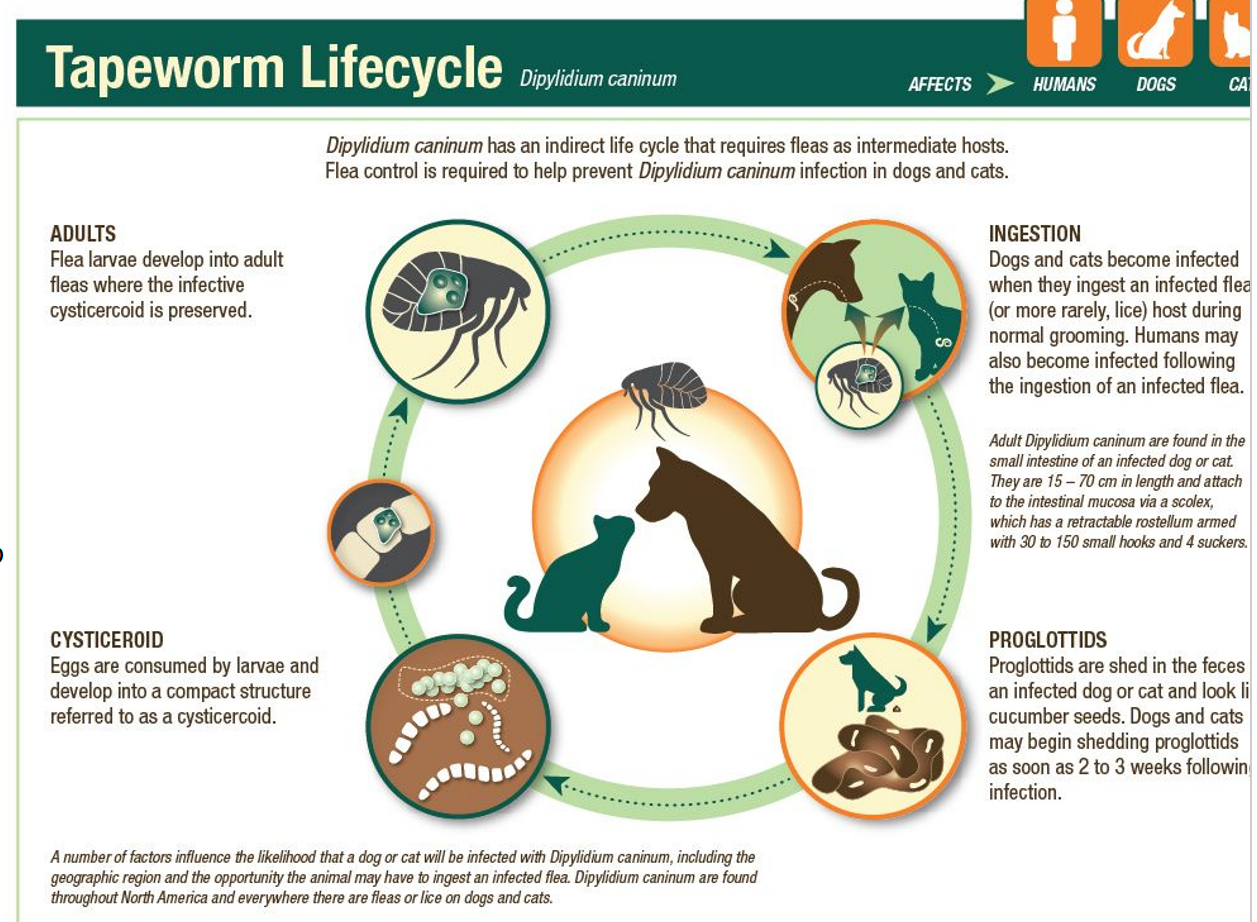
trematodes…
whats the common name of these
where do they commonly live in the host
direct or indirect life cycle?
describe how they’re transmitted
flukes (look like footballs)
BV’s, GIT, lungs, liver
indirect
pass in feces → enter a snail (intermediate host) → pass to vegetation → eat plant = infected
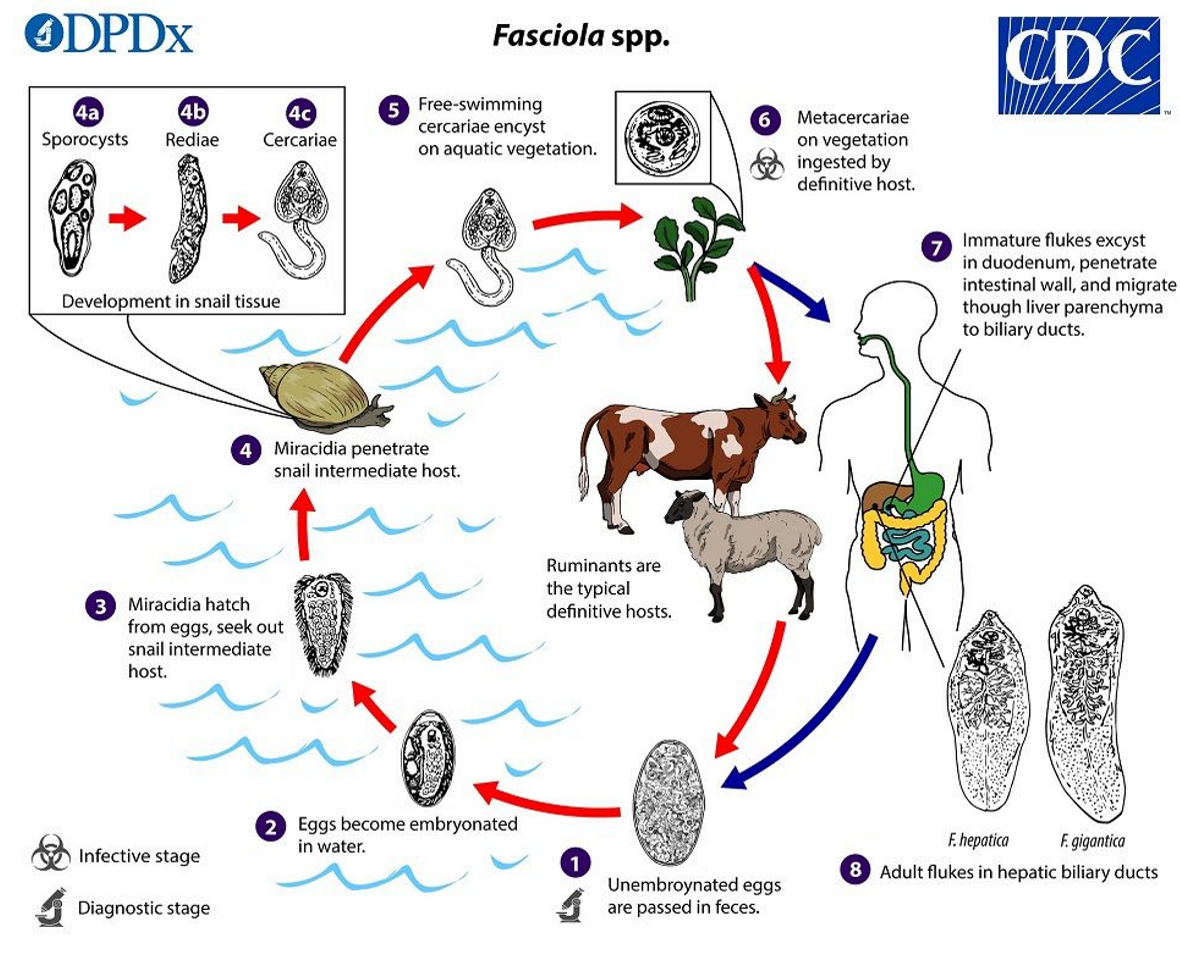
focusing on the environment is a good way to manage psites.
…
what place are worms commonly picked up in dogs (think about where larva accumulates)
are psites worse in hotter or colder climates? (e.g. south vs north USA), explain
do psites survive & transmit more in low or high stocking density barns, explain
why is soil type important
dog parks (larva lives in poop)
hot → hot accelerates their life cycle, cold kills them
high → more feces, closer contact for ectopsites to jump ani to ani, stress weakens immune system
some are more attractice to psites (e.g. fleas loveee sandy soil)
pasture rotation is a great way to reduce parasites.
explain what this is and why it works
giving ani just a section of pasture at a time → rotate them thru the sections weekly, monthly, etc.
this gives larva a chance to go thru its life cycle before animals get there and it’ll die cause there’s no host for it in time
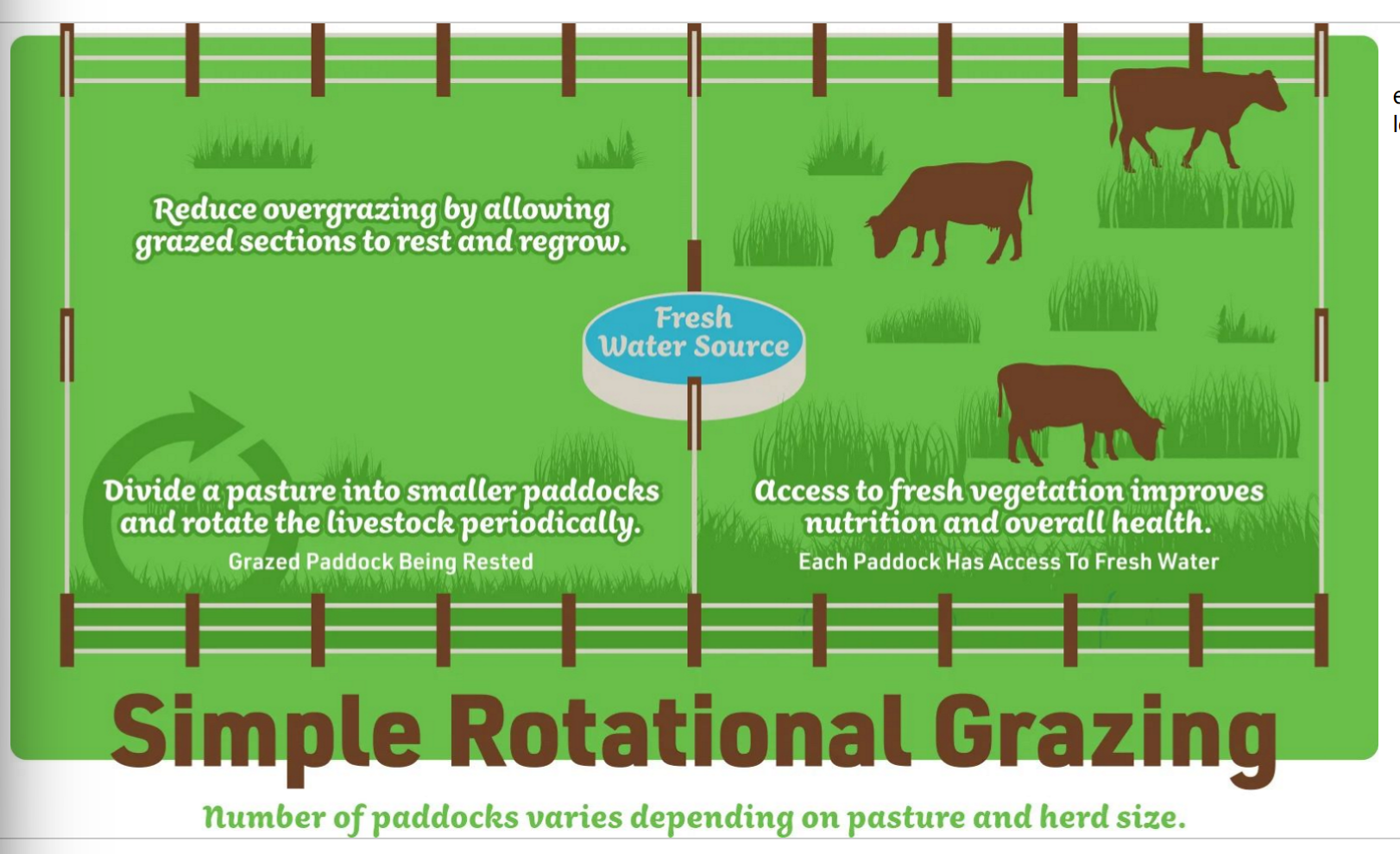
adequate nutrition is a great way to reduce parasites.
explain why this works
is energy or protein more important for this
phytonutrients are an example of nutrients that help with this → explain how
it improves the hosts overall health, resistance, & resilience to/ability to fight disease
protein!!
these are compounds found in plants → ani eat them and worms hate them
multi species grazing is a great way to reduce parasites.
explain why
lots of psites are host/species specific so this breaks its life cycle so it never gets to its host
e.g. goat roundworms love goats, not cows → put cows on pasture → cows eat all the worms → none left when we put goats back on pasture
giving animals feed additives is a great way to reduce parasites.
explain how bioworma & ionophores do this
bio: this is a fungus that goats eat → poop out → fungus attacks worms
ion: commonly fed to LA’s to promote growth & they can have anit-protozoal properties if we give extra
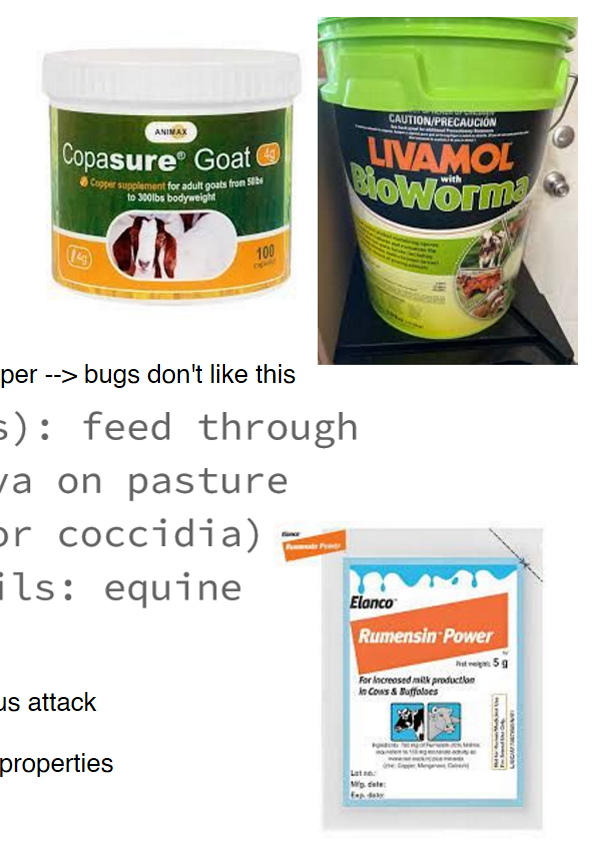
dewormer/anthelmintic resistance is a hugeeeee issue in FA’s.
we can use fecal egg counts to determine if we have resistance by looking at fecal egg count reduction (FECR).
…
explain how we get FECR and what % is considered resistance
do FEC → deworm → do another FEC ~2 weeks later to see if dewormer is actually working
we have drug resistnace if fail to reduce eggs by >95%
describe the most common way we control/prevent psites in:
SA’s
equine
FA’s
SA: regular preventatives
equine: strategic deworming (tx for what psites are found on FEC’s), pasture mgt
FA: same ^ & consider withdrawal times